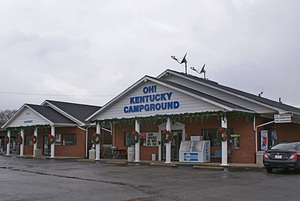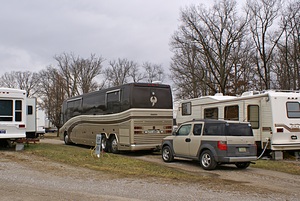2014/11/24 (M) Martin Diesel
I set my alarm for 6 AM and got up when it sounded. I finished packing all of the things I had in the bedroom and then stripped the bed. At 6:45 AM I moved everything to the bus and started my final departure routine. I set the car for towing, opened all of the auxiliary air valves, and switched the chassis batteries on. I cleared the kitchen counter and checked that the refrigerator doors were latched. I then turned off the shore power, stowed the cord, secured the utility bay, and checked that all of the bay doors were closed and locked. I started the main engine and put it in high idle to help build air pressure. Once the bus was running I shut off the lights in the house and locked the door behind me.
I pulled out of Butch and Fonda’s place at 7:28 AM with the temperature in the low 50’s and strong winds out of the southwest. I took SR-16 east to US-31 south to US-24 east to Roanoke (IN) where I turned east on County Road N 900 E (Vine St.). I followed N 900 E, a two-lane road with a lot of heavy truck traffic, for about four miles where it became I-469 with exits for I-69. I-469 took me around the south and east sides of Ft. Wayne, Indiana to exit 21 where I rejoined US-24 eastbound. Except for the wind it was a shorter and easier run that staying on US-24 all the way to I-69.
The stretch of US-24 east of Ft. Wayne, Indiana is apparently new enough that my relatively new and updated Rand McNally RVND GPS did not know it existed and kept trying to route me onto the old roadway. Although not a limited access highway, it was posted at 65 MPH and I was able to travel comfortably at 62 MPH with very light traffic for the entire trip. I crossed into Ohio and continued on towards Defiance. I passed the main exit for Defiance and took exit 28, Domersville Road (OH-284), a little farther to the east. I headed south for about a mile and turned left on Deerwood, which intersects with County Road 424 (OH-284 passes over CR-424). Another mile east along the north bank of the Maumee River and I was at Martin Diesel. The new speedometer/odometer worked perfectly and I did not get a Check Engine Light the entire trip. At this point the “fuel temperature voltage high” problem is either fixed or has stopped registering fault codes. My transmission retarder was still not operational but I managed my deceleration by anticipating the need to stop and manually selecting lower gears. I arrived with the house batteries at 97% state of charge, indicating that the 24 VDC Zena power generating system appeared to be doing its job maintaining the house battery bank.
I pulled off the road, parked, and went in. Jim Martin wasn’t there but Paul seemed to know I was coming. I had to unhook the car and move it out of the way. I then had to back the bus between a racing trailer and a light/power pole with no more than 18″ to spare on each side. I raised the tag axle to shorten the turning radius and pulled around behind the building to the spot where they wanted it.
Paul assigned Jay to work on the generator and Mike came out to look at it. The hour meter on the unit showed 3099 hours and the one in the house systems panel showed 2625 hours but I had no idea if either of those were correct. Mike said it was important to replace the rear bearing on the generator before 5,000 hours and I decided to have them go ahead and do it. The unit was put in service in October 1990, after all, and I have no idea how many hours are actually on it or if/when/how it has been serviced. Jay changed the oil and filter, the fuel filter, and the air filter, and replaced the drive belt. I got a spare set of filters and a belt to take with me.
When Jay was done servicing the unit he started the unit to check for leaks and check the speed (frequency). It was running at 62.3 Hz with no load, and that is where they like to have them set. Jay pulled the cover off the free end of the generator and checked the gap, which he said was good (equal all the way around). He showed me the part he had to remove to get to the rear bearing and explained that it could take up to 2.5 hours to complete the job. That would have delayed my departure enough that I would arrive home after dark, or have to spend the night there. Getting home after dark was not an ideal scenario on such a windy day and I was anxious to get home rather than spend a night on the road. Jay also indicated that a replacement part was no longer available should this one get damaged. He had done this job before and was confident he could do it without damaging the part, but it was clear that he wasn’t keen on the idea, especially as he was working outside in falling temperatures and serious wind.
Jay and I discussed the situation with Paul and his opinion was to hold off and replace the bearing as part of a more extensive out-of-vehicle overhaul. Between the time required, the risk involved, and the “fact” that the unit was only 62% of the way to the recommended replacement hours, I decided to have them quit while we ahead.
Jay wanted to run the unit under load for a while so tried to turn on the air-conditioners, but they were all dead; no power. I turned on the electric toe kick heaters instead, but only the front and rear ones would run, so I also turned on the auxiliary air compressor. The refrigerator was running as was the house battery charger. The bathroom electric heater is on its own circuit breaker and Just this past week I tied in an outlet to that circuit for the vacuum cleaner and used it as recently as yesterday. I checked and had voltage and current on both legs, so it seemed unlikely that the GenSet was the problem.
Jay had the work wrapped up by 2 PM and wrote it up so I could settle the bill. I had to back the bus out and get it turned around so I could hook up the car and pull out headed west on CR-424 back to Deerwood and then north on Domersville and back to US-24. My route home from there was US-24 east to I-475 north to US-23 north. I was unsure of the status of the construction work on Grand River Avenue so I sent Linda a TXT message before I pulled out. She confirmed that the construction was done so I exited US-23 onto westbound I-96, took exit 145 for Grand River Avenue towards Howell and then north on Hacker to our street. I pulled into the driveway at 5:02 PM. The wind was very strong and gusty out of the southwest the entire drive, and the temperature had dropped into the 30’s, but the bus and I did just fine, even without the transmission retarder.
Linda got home about five minutes after me. I turned on the outside RV outlet, plugged the coach in, closed various air valves, and turned off the chassis batteries. We sat for a while in the living room with the fire logs blazing and enjoyed a cup of hot tea. Butch had called me while I was driving so I called him back around 6 PM and brought him up to date on the electrical issues I discovered while I was at Martin Diesel. After another cup of tea Linda started fixing dinner while I unloaded clothes, technology, and some food items from the bus. We had an Amy’s Pizza Margherita for dinner with some Red Guitar Sangria. Yum. I enjoyed my time at Butch and Fonda’s, and got a lot done while I was there, but it was nice to be home.
2014/11/25 (T) New Tires
We slept in and had a lazy start to the day, enjoying our morning coffee in the living room to the warmth and glow of our new natural gas fireplace logs. I finished up yesterday’s blog post and continued working on the article for the GLCC newsletter about the October Surplus and Salvage rally. As much as we both would have liked a down day, and could have used one, we had too much to do to get ready for our family gathering on Thanksgiving and to get us, the bus, and the house ready for our departure on Sunday.
The Salvation Army was scheduled to pick up our old propane range today sometime between 8 AM and 7 PM, so that required us to coordinate our errands so that one of us was always at home until they got here. As it turned out the Salvation Army truck showed up at 9:15 AM, loaded the range, and were on their way by 9:30 AM. That freed up how we went about the rest of our day.
Linda got several calls from the bakery and ended up working on software issues off and on throughout the day. She cut my hair, which was overdue, after which I worked on the design for the organizer I’m going to build for the Honda Element. I unloaded the back of the Element so I could take measurements and to make room for the wood I needed for the project. I called Bill Gerrie in Ontario to discuss the transmission and engine computer issues that have appeared with the bus. I had no sooner finished the conversation when it was time for lunch.
After lunch I took a box of gifts for my sister to the UPS Store in Howell. I stopped at Teeko’s Coffee & Teas just up the street and ordered three different coffees for pickup on Friday. I then went to Discount Tire to get new tires for the Element. This is the busy season for Discount Tire and it took two hours before they were done, but to their credit that is exactly how long they told me it would take. I switched from the B. F. Goodrich trail-rated tire that was on the car to a similar, but better rated, Cooper Tire. I was told that the new tires should be a bit quieter and have better traction on slick surfaces but still hold up to the dirt roads in our area and when we travel.
Home Depot was next door to the tire store so I stopped there to see if they would cut plywood sheets to smaller sizes. They would, but they had pieces already cut to 2’x4′ and 2’x2′. I had planned to use 3/4″ plywood, but the 1/2″ pieces seemed sufficiently strong for my purpose. I assessed my design with respect to these sizes and decided they would work. I picked up some 36″ long 1″X1″ material to use as cleats. The size of this material made it easy to handle and get into my car. I bought a bottle of Tightbond wood glue but forgot to buy screws, so I stopped at Lowe’s and picked up some nice star drive 1-1/4″ outdoor wood screws with special points and a cutaway drill-like design. I will still pre-drill the holes to make sure the cleats do not split.
Linda had a 4 PM appointment to have her hair cut by Renee at the J. C. Penney’s salon at 12 Oaks Mall, so she was gone by the time I got home. I unloaded the wood I just bought, threw some laundry in the dryer, and got back to work on the GLCC rally article. Linda got home shortly thereafter and started putting dinner together. She made a whole wheat pasta with sun-dried tomatoes, onions, garlic, and greens lightly sautéed in olive oil. We had a glass of the Red Guitar Sangria to go with it. I have missed her cooking while I was away working on the bus.
After dinner I sent a TXT message to Chuck to let him know I was back and had some issues with the coach. I finished the GLCC rally article and sent it to the newsletter editors, Scott and Tami Bruner, and the rally hosts Pat and Vickie Lintner.
The things on our list that did not get done today included the following bus-related items:
- Completely unloading the house portion of the bus.
- Cleaning the interior of the bus.
- Checking/diagnosing the bus AC house circuits.
- Removing/checking/reinstalling the ATEC (?) connector on the DDEC II.
I also need to move items from the garage to the library that cannot be allowed to freeze and remove the wasp nest from the front of the house.
I plan to work on the organizer for the Element tomorrow morning and leave the bus stuff for Friday and Saturday. Brendan is bringing Madeline over tomorrow. She is going to stay overnight and we will take her to Meghan’s house on Thursday for the family Thanksgiving gathering. We will get some work done while Madeline is sleeping, but she gets our full attention when she is awake.
2014/11/26 (W) Return of Schmoo
I awoke at 5 AM and realized fairly quickly that I was not going to fall back asleep so I got up, put on my nice warm winter robe and fleece-lined slippers, and worked at my computer and iPad until Linda got up a little before 8 AM. I copied and pasted draft blog posts from my e-mail to MS Word from yesterday all the way back to November 7th. I have tried to write every day but have not uploaded to the web since the end of September. Next I organized the photographs I have taken this November. I then started updating the MS Excel spreadsheet I use to list my various bus projects and track their status.
When Linda arose she made a pot of coffee, so I took a break and enjoyed the brew. I had planned to start working on the plywood divider for the Back of the Honda Element, and Linda had planned to start preparing some of the food for tomorrow, until Brendan called at 8:45 AM to let us know he and Madeline would be at our house in about an hour, if that was alright with us. Of course it was. Given the short time until they arrived I continued working at my computer and Linda took a call from the bakery.
Brendan and Madeline arrived a little before 10 AM. Madeline was quickly engaged with the house and her special toys and books. Brendan stuck around through lunch and then headed back to Ann Arbor. Schmoo went down for her nap at 12:30 PM and I took advantage of her nap time to start building the first of two plywood dividers for the car. The first thing was to remove the passenger side rear seat from the Element, which took both of us. Linda then worked at her desk on bakery and personal items and made two relishes for tomorrow: regular cranberry-orange relish, and “Mama Stamberg’s Cranberry Relish,” made with cranberries, onions (Linda substituted shallots), horseradish, and “sour cream” (Linda used a vegan version, naturally). At the point where I had to assemble two sides and a shelf Linda helped hold the pieces together while I secured them with glue and screws.
We finished the divider, except for a couple of notches I have to cut out, around 3:15 PM just as Madeline was starting to wake up from her nap. Linda got her up and dressed at 3:30 PM. They played at various games while I took a little time to call my sister. I played with Madeline until dinnertime at 5:30 PM, giving Linda a chance to get the meal on the table. We all had the same thing; vegan “chicken nuggets”, corn kernels, baked sweet potatoes, and brown-n-serve dinner rolls with some orange juice to wash it down.
I amused Madeline while Linda cleared the table and loaded the dishwasher. We played at various things that delight an almost two-year-old child until 7:10 PM when I turned on the fireplace logs and dimmed the lighting in the living room. We started putting toys away and creating a calm mood to counter Madeline’s tendency to get slightly frantic just before she’s tired enough to go to bed. Linda got her changed into her pajama’s (“jammies”) at 7:30 PM and we all sat and watched the fire dance in the fireplace for a while until Madeline said she was ready to go to bed.
Once she was asleep we checked the fit of the divider around the air-compressor and determined it was good. I had a brief call from Pat Lintner about the GLCC rally article and exchanged TXT messages with Chuck about our transmission issues. I did a final check of e-mail and shut my computer down for the night. We had a few cookies and then turned in for the evening.
2014/11/27 (R) Giving Thanks
Linda was up at 6:30 AM and working in the kitchen on dishes for the family gathering later in the day. Madeline woke up at 7:00 and Linda had her up shortly thereafter. I got up and put on my robe and supervised her first play of the day while Linda got breakfast ready. Linda made a pot of oatmeal with raisins, which we enjoyed, but Schmoo preferred her banana and “toast” (bread) with peanut butter. We all had orange juice and the adults had coffee. I suspect Madeline will learn to enjoy coffee much younger than most people, but not for quite a while yet.
There are lots of little rituals at this age and one of them is the washing of hands and face after a meal. Madeline likes our hall bathroom because the mirrored walls on three sides of the counter allow her to see an infinite set of receding images of herself. She and I sat in the living room and played with Legos while Linda cleaned up the breakfast dishes. I then took a shower while Linda played with Schmoo. Once I was dressed I took over child amusement duties while Linda showered and dressed and gathered up all of the stuff that had to go with us to our daughter and son-in-law’s house for Thanksgiving.
We took two cars with Linda driving Madeline in her car and me following in mine. Our son and daughter-in-law are going to keep Linda’s Honda Civic for the winter, so they will take it to their house after dinner and I will drive us home. Linda had finished the holiday and birthday shopping over the weekend and we brought all of the presents with us, to be distributed and opened at the appropriate time in our absence. We got to Chris and Meghan’s house around 11 AM. Katie (Chris’ daughter) was already there, having spent the night, and Brendan and Shawna showed up around 11:30 AM, completing the family gathering.
Madeline was very excited to see her parents, of course, although she is also very comfortable being away from them if she is with people she knows and trusts. She was a busy girl for about an hour and then went down for her afternoon nap. That gave the adults a chance to visit and finish the dinner preparations. Madeline got up at 2:30 PM, a shorter than normal nap, and was active until dinnertime. We brought a bottle of champagne that we used to toast the occasion before sitting down to eat at 4 PM.
We had a nice assortment of dishes for dinner, many of them vegan in consideration of how Linda and I choose to eat as well as Meghan’s food sensitivities. The meal was the combined effort of Linda, Brendan, and Meghan and included turkey and gravy that Brendan made and everyone but us had. Everything else was vegan. Linda made Tofurkey and gravy, dinner rolls, cranberry orange salad, Mama Stamberg’s cranberry salad, quinoa salad with pomegranates and pistachios, and mashed sweet potatoes with currants and spices. Meghan made white chunk-style mashed potatoes, corn bread stuffing, and green bean salad. Brendan and Shawna brought a couple bottles of wine, a 2012 German Kreuznacher Kronenberg Riesling Spatlese and a 2010 French Chateau Le Gay Bordeaux. It is fun having adult children who enjoy and appreciate these things.
Shawna and Meghan changed Madeline’s dress and Brendan took “Christmas” pictures, hoping to get one they could use on their holiday card. While the photo shoot was going on Meghan made an avocado chocolate mousse for dessert. She served the mousse with fresh berries and also had a spiced pumpkin cake she had made earlier. Both were vegan and amazing. The entire meal was skillfully prepared and very tasty; as good a Thanksgiving dinner as one could want.
We visited for a while after dinner and Katie received 18th birthday gifts from her dad and Meghan and from us. Brendan and Shawna gathered up their stuff first and got Madeline bundled up against the cold for the ride home. Linda gave Brendan the registration and insurance and two keys to her car and he drove it to their house for the winter. We packed up some leftovers and left about 15 minutes later. When we got home I made some green tea while Linda called her sister, who spends Thanksgiving with their brother Ron, his wife Mary, some of Ron’s children and her family. At least that is what they usually do. I checked e-mail and realized that MS Outlook 2013 has been shuffling e-mails to my junk folders since July, so I dragged all of them back to my various inboxes. We watched an episode of NCIS on the iPad and then went to sleep.
The notion of Thanksgiving, of setting aside a special day to “give thanks,” is based at its core on the idea that something outside ourselves is responsible for what we have in life, whatever degree of good fortune (or lack thereof) we might have experienced, either in the prior year, or cumulatively. For many people this is a giving of thanks to a higher being that is globally credited with this responsibility. That idea holds no meaning for us, of course, but we certainly recognize that there are numerous people who daily impact our situation in life and are (or should be) thanked for what they do. When the interactions are direct there is the opportunity to say “thank you” and we try to do that. Yesterday and this morning, for example, we were gently reinforcing Madeline’s use of “please” and “thank you” in her common, daily interactions with people.
I am certainly glad to be with family on a day that is set aside for enjoying their company and reflecting on the fact that all of us have so far worked out very good lives and have bright futures to the extent they are under our control. I looked up the term “gratitude” and although Wikipedia links it to “thankfulness” and “appreciation,” and discusses its religious connections at length, it also discusses the recent interest in the study of gratitude by psychologists as a positive emotion that enriches our own lives and the lives of others. I am, in that sense, grateful for the people in my life and the life we have and do not have a better term to express a conscious recognition of the quality of my life and the importance of the people in in it.
2014/11/28b (F) Black Friday
The leftovers have barely cooled off and the commercial holiday season is red hot. I know, because we are receiving a steady flow of e-mails alerting us to “once-in-lifetime, lowest-price-of-the-season, never-to-be-seen-again, Black Friday” deals. Pardon me if I’m a bit bah humbug about this, but I am still digesting my dinner from yesterday and I am just not that found of crowds, shopping or otherwise. No, we slept in, had our usual breakfast, drank our coffee by the warmth and glow of our fireplace, played a few games on our iPads (because we are retired and we can), and got ready for our final two-day push to get the bus, the house, and us ready for the winter.
We are more relaxed about all of this than we were last year for several reasons. For one, we are now “experienced” so we have a clearer picture of what we need to do and how long it will take. For another, we are leaving 20 days earlier than last year with a weather forecast that is still colder than we would like but without significant snow or the threat of ice. We also do not have to be at specific places on specific dates, so we have more flexibility in our preparations and travels than we had last year. We have a different guy (Kerry Fear) doing snow removal this year and are more comfortable that he will reliably take care of our driveway since he lives nearby and only does about a dozen residences (no commercial properties) including our neighbor to the rear (Sean) which is where we got his name. Finally, we now have natural gas being piped to the house and are disconnected from our propane tanks, which means we do not have to worry about running out of fuel and not being able to get more and/or being gouged with spot market prices.
Once we got busy our first task was to put the air-compressor box in the Honda Element to see how it fit and so I could get final measurements for the second box that will go behind the driver side rear seat. We then unloaded the house portion of the coach and brought everything into the (fixed) house so we could: a) clean the inside (of the bus), and; b) sort through all of the “stuff,” decide what was going back onboard, stage it for reloading, and store what was staying behind.
I helped with the unloading process and then busied myself finishing the air-compressor box. I had planned to build a second box to put behind the driver side passenger seat. However, once I got the air-compressor box trimmed and we got it installed there wasn’t enough room for the second box. I also thought about building a shelf to put under the dinette seat so the dinette base could slide under it, allowing us to store things under the seat without them being disturbed by the in/out motion of the table. I did not have pieces of plywood the size I needed and Linda correctly noted that we planned to tear out that side of the bus next year anyway so perhaps this wasn’t the best use of my time. She’s good that way.
Instead of building things I started sorting and staging all of the stuff we took off the bus this morning. Some of it is staying home, some will go in the car, some will go in the bus bays, and the rest will go in the living area of the bus. Somewhere in the middle of that process we took a break and had some of the leftover quinoa salad, only Linda served it warm instead of cold. We had a few grapes to go with it.
I decided that I wanted to take our extra Webasto burner assembly with us with the hope that I might order a blower bearing kit and new style banjo fuel fittings and rebuild the burner once we get settled. The burner was installed in Butch’s old Aqua-Hot so I removed it. We put it in a 10 gallon ZipLock bag, wrapped it in bubble wrap, and stored it vertically in a 5 gallon utility bucket with the nozzle and ignition electrodes pointing up. The bucket had a gasket sealed lid and we had been using it to store cat food until today. The burner is a very expensive assembly and we needed to ensure it did not get damaged.
While Linda worked at her desk I investigated the problem with the (lack of) AC power to the air-conditioners. I consulted the conversion documentation, which includes a list of the numbered wires in the 12VDC distribution panel in the front center ceiling area, and it indicated that wire #17 was the feed for the air-conditioning switches. I located wire #17 in the panel and checked for voltage on the feed and load sides of the 2 Amp blade fuse. I had 13.3 volts on the feed side but nothing on the load side indicating a blown fuse. I pulled it out and examined it and it was definitely open. I checked a replacement fuse for continuity before I inserted it but forgot to check for voltage on the load side before turning on the switch for the rear air-conditioner. (I chose the rear air unit because it does not involve the Mac solenoid air valve that controls the shutters in the front of the spare tire compartment where the front and middle air-conditioner compressors are located.) I did not get power to the unit so I pulled the new fuse and it was blown open. Clearly there is a short but I will have to track it down another time. It was getting dark and dinner was about to be served.
We had leftovers for dinner; Tofurkey with vegan gravy, cranberry-orange relish, and dinner rolls. Linda also roasted some fresh asparagus to round out the meal. After dinner I drove to Teeko’s to pick up our coffee order but discovered that they closed at 4:30 PM today so I drove back home. It was the end of the evening rush hour, dark, snowing, and Black Friday so I had no interest in being out on the road or in any stores.
I brought both of our GPS units into the house intending to update them tonight, but it’s going to be tomorrow. I called Butch and talked to him briefly, and then called Chuck and left a message. He called back and we had a nice chat.
Our pace was not frantic but we were busy most of the day and very focused on getting certain things done. The bus is clean (on the inside), we are in the process of organizing all of the stuff that has to go onboard, and the car is set up so we can take the large air-compressor and still carry lots of other stuff, including a spare starter motor for the bus engine and a spare Webasto burner head for the Aqua-Hot. Trying to figure out what spare parts to carry is a never-ending process, and whatever we bring we usually don’t need but wish we had brought something we left at home. It is one of those things we just have to accept about this lifestyle.
2014/11/29 (S) 73s
Today was our last opportunity to have breakfast with our friends from the South Lyon Area Amateur Radio Club (SLAARC) until we return from our winter adventure. We overslept, got there about 15 minutes later than normal and left earlier than usual. “Seven Three” (singular) or “Seven Threes” (plural) is what ham radio operators often say when concluding a conversation. It’s a shorthand for “goodbye” or “farewell till next time.” It isn’t shorter when spoken, but it’s a carryover from CW operation (Continuous Wave, more commonly known as Morse code) where it only involves keying two numbers. Ham radio has a lot of things like that which adds to the challenge and enjoyment of the hobby.
From breakfast we headed to a couple of different banks, Walmart, and finally Teeko’s Coffee and Tea to pick up our order of custom roasted beans. We then headed home to start loading the bus. Linda kept adding items to her shopping list as she only wanted to make one trip to the store if possible.
It was a busy day and would be difficult, and perhaps a bit tedious, to try to describe exactly what we did and in what order. Basically, I sorted stuff according to where it had to go and then loaded/organized the car and the front bus bay while Linda took care of organizing the living area, which included all of the food and clothing. I replaced our sewer hoses with the new RhinoFLEX components from Camco and filled our fresh water tank with nice filtered/softened water.
While Linda was at the store I worked on the transmission retarder problem. I disconnected all of the harnesses from the DDEC II engine control module and checked for bent pins. All of the pins where present and straight so I carefully reconnected all of the harnesses. I checked the front and rear chassis electrical bays and found three circuit breakers that had tripped; one in the front that had something to do with the transmission retarder switch and two in the rear, one of which had to do with the retarder and dashboard “tattle tale” light. The other one was marked for the air dryer. I connected the chassis batteries and turned the ignition switch to the ‘on’ position and checked that the circuit breakers did not trip.
I decided I wanted to start the engine so I turned on the electric block heater, the Aqua-Hot electric heating element, and the Aqua-Hot engine pre-heat pump and let them run for an hour. I started the bus and backed it up about 10 feet and then pulled it forward to its original parking place. I had the retarder switch on with my foot off the accelerator and on the brake pedal, but the tattle tale light still did not come on. I took the cover off of the dashboard and removed the light bulb from the tattle tale to see if it was burned out. It wasn’t, so I buttoned everything back up. I put all of the tools back in the correct tool boxes and loaded them into their storage places for travel.
Linda returned from her shopping trip and finished loading food onboard the bus. She also picked up some of our favorite food from La Marsa; crushed Lentil soup, green salad, and Koshary, with pocket bread and garlic spread. Not having to cook gave her the time she needed to go through the mail and pay bills.
I made my first pass at selecting clothes so Linda could load them on the bus while I made a run to Walmart for batteries for her BAHA and some shaving cream. I stopped at Lowe’s for some 1.25″ 8×32 machine screws (that might work to mount the inclinometer) and some decorative head wood screws (that might work in place of the filler plugs used to hide the screws in the woodwork). I then stopped at O’Reilly’s Auto Parts for two 12 VDC automotive accessory plugs.
When I got home Linda heated up dinner and we enjoyed a nice meal that did not take a lot of time/effort on her part. After dinner I started a second load of laundry (Linda did the first one) and then took my computer, digital camera, and both GPS units downstairs to my desk. I transferred photo files to the NAS drive that will remain at home and then went through the update process on each GPS. When the laundry was done I made my final clothing selections. I did not have time to gather up CD’s, so we will do that in the morning. As usual, the GPS update process took a very long time so I left it to run overnight and went to bed.
2014/11/30 (N) Arizona Bound (Eventually)
I woke up at 4:30 AM and got up to check on the progress of the GPS update process. I also needed to install 96 updates on my Linux box so I started that process. While I was in my office I put pre-cut pieces of insulation in the three windows of my office and the window in the sump pump closet. I went back to bed at 5:30 AM and slept until Linda got up at 7 AM.
We skipped breakfast and started the final loading of the bus, which included shoes, coats, and computers. When everything was onboard we connected the car for towing. We then disconnected the AC shorepower cord, stowed it for travel, and turned our attention to closing up the house.
Linda closed all the blinds, set the thermostats back, and opened all of the cabinets that contained water pipes while I went around and poured RV antifreeze down every trap in the house. She also turned off the pilot light for the gas fireplace logs. We turned off the well pump, shut the valve on the incoming water line, unplugged all of the water treatment equipment, and removed the batteries from the softener and sanitizer. She took pictures on her phone of everything in its normal (operating) condition so she could turn it back on when she flies back in February to do tax work. I showed her where the small gas shutoff valve was located and she turned that off, cutting off gas to the fireplace, the kitchen range, and the outside grill quick-disconnect. Two of the computers still needed to install their updates. We did not want to wait for them to complete the process so I selected “Install updates and shut down.” Our second-to-last task was installing the glass storm door insert in the front door and storing the screen insert downstairs. Our last task was putting the cats onboard the bus.
One of the decisive moments in this departure process, albeit not at all dramatic, was locking the front door to the house for the last time in quite a while. Another was walking down our relatively new front stairs and sidewalk, which had made loading the coach a much more pleasant and safe endeavor, again for the last time in a while. Or perhaps it was finally turning the ignition key, such a small simple object, and bringing the large, powerful, and complex Detroit Diesel engine to life along with the rest of the coach. Or maybe it was pulling up the tag axle in preparation for the tight 180 degree turn we had to make to get out of our pull-through driveway and onto our street headed in the right direction. But the final, decisive moment, was putting the transmission into 1st gear, releasing the parking brake, touching the accelerator, finally moving the great beast of a bus forward, the first inches of a round trip that will likely cover at least 5,000 miles. We noted the time of our departure at 10:52 AM EDT, marking the end of preparation and the beginning of travel.
We turned off of our street onto Hacker Road which, we learned from Saturday’s mail, is finally going to be paved from Golf Club north to M-59. Hacker is the eastern boundary of our township and the western boundary of the township to the east and the two townships are apparently going to split the cost of the project equally. This was welcomed news for us as it will reduce the amount of dirt road we have to deal with to just our street.
Our first destination was Twelve Mile, Indiana where the bus has been since late September. We took my preferred route, following M-59 west to I-96 west to I-69 south into Indiana where we picked up US-20 westbound. I really like this stretch of US-20; there are very few stops or places we have to slow down, the road surface is in excellent condition, and the last 20 miles before US-31 is a multi-lane divided limited access freeway. We exited US-20 just south of South Bend, Indiana onto southbound US-31. This was the first time Linda has been on the new section of US-31. We passed SR-16 (IN) and drove another six miles to Gallahan’s Truck Stop and topped off the fuel tank. Based on the mileage on the new odometer our fuel economy computed as 4.9 mpg. I had topped off the tank this past Sunday but I had also been running the Aqua-Hot. Still, we were expecting more like 5.9 MPG, which is 20% better.
We back-tracked north on US-31 to SR-16 west and arrived in Twelve Mile just after 4 PM. I pulled into the U-shaped driveway that services the grain elevator across the street from Butch and Fonda’s place, parked the coach, and shut off the engine. We grabbed our rain coats and went in search of Butch and Fonda. We found them in the parts room working on insulating their well pump, pressure tank, filter, and lines. They had a dumpster sitting where I usually park our coach so Butch moved it inside the warehouse with his forklift. While Butch took care of that we unhooked our car and moved it out of the way. Linda then spotted for traffic and got me backed into our parking spot. We were positioned a little better for electrical power but still had to use our 50 Amp extension cord to reach the outlet. With temperatures dropping back below freezing tonight and Linda cooking our meals I wanted the full electrical hookup rather than the 30 Amp outlet by the automotive garage.
We visited briefly with Butch and Fonda but did not want to take them away from their work. Fonda and I gave Linda a tour of their bus, after which we retired to our own coach for the evening. Jasper had come out from under the front passenger seat as soon as we got parked. Juniper was much slower to emerge but finally did. Linda made seitan stroganoff for dinner, served over white rice (the way I like it) accompanied by a nice green salad and a glass of Moscato. We were very tired and went to bed at 8 PM, but it was nice to finally be back on the road together.
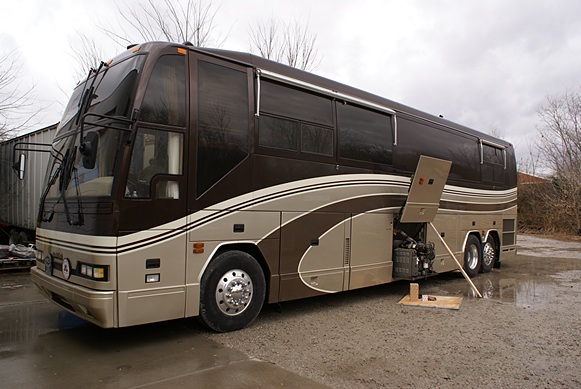
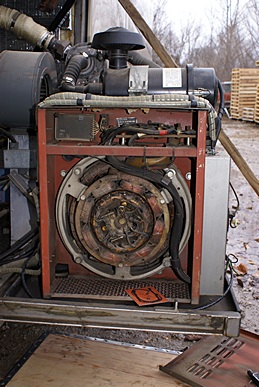
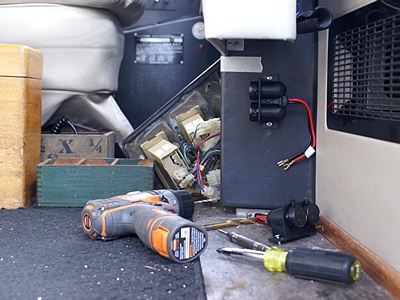
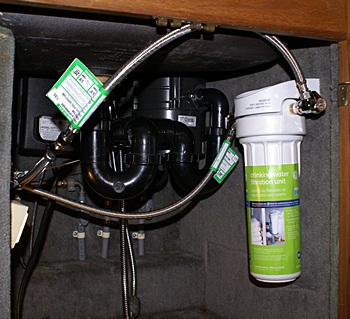
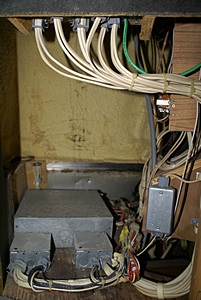
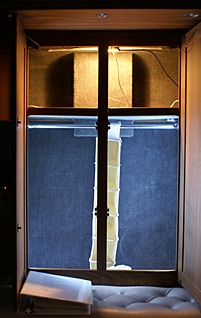
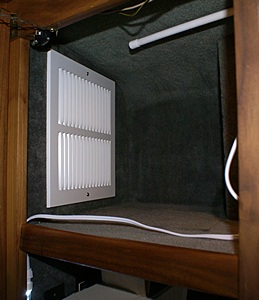
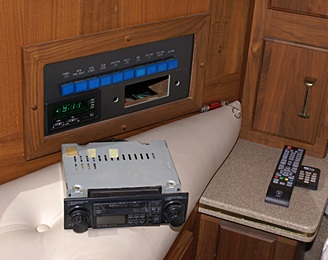
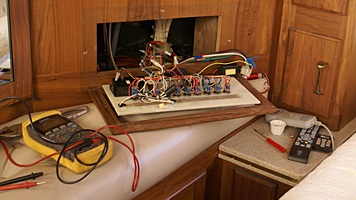
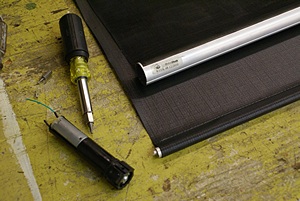
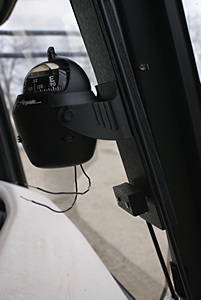
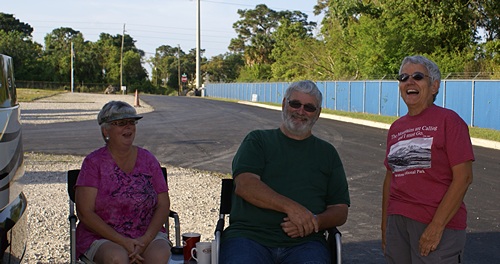
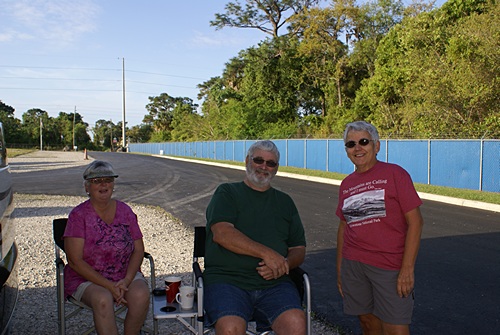
 If not, perhaps Ken will have a Vernal Equinox Special Release or a Summer Solstice Special Release. Any excuse to buy Ken’s mead.
If not, perhaps Ken will have a Vernal Equinox Special Release or a Summer Solstice Special Release. Any excuse to buy Ken’s mead.